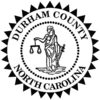Durham County | |
|---|---|
 | |
| Motto: "Live. Grow. Thrive." | |
 Location within the U.S. state of North Carolina | |
 North Carolina's location within the U.S. | |
| Coordinates: 36°02′N 78°53′W / 36.03°N 78.88°W | |
| Country | |
| State | |
| Founded | 1881 |
| Named for | Bartlett Snipes Durham |
| Seat | Durham |
| Largest community | Durham |
| Area | |
| • Total | 297.86 sq mi (771.5 km2) |
| • Land | 286.53 sq mi (742.1 km2) |
| • Water | 11.33 sq mi (29.3 km2) 3.80% |
| Population (2020) | |
| • Total | 324,833 |
| • Estimate (2023) | 336,892 |
| • Density | 1,100/sq mi (420/km2) |
| Time zone | UTC−5 (Eastern) |
| • Summer (DST) | UTC−4 (EDT) |
| Congressional district | 4th |
| Website | dconc |
Durham County is a county located in the U.S. state of North Carolina. As of the 2020 census, the population was 324,833,[1] making it the sixth-most populous county in North Carolina. Its county seat is Durham,[2] which is the only incorporated municipality predominantly in the county, though very small portions of cities and towns mostly in neighboring counties also extend into Durham County. The central and southern parts of Durham County are highly urban, consisting of the city as well as several unincorporated suburbs. Southeastern Durham County is dominated by the Research Triangle Park, most of which is in Durham County. The northern third of Durham County is rural in nature. Durham County is the core of the Durham-Chapel Hill, NC Metropolitan Statistical Area, which is also included in the Raleigh-Durham-Cary, NC Combined Statistical Area, which had an estimated population of 2,368,947 in 2023.[3]
- ^ Cite error: The named reference
2020CensusQuickFactswas invoked but never defined (see the help page). - ^ "Find a County". National Association of Counties. Archived from the original on July 12, 2012. Retrieved June 7, 2011.
- ^ "Metropolitan and Micropolitan Statistical Areas Population Totals: 2020-2023". United States Census Bureau, Population Division. March 14, 2024. Retrieved March 15, 2024.


